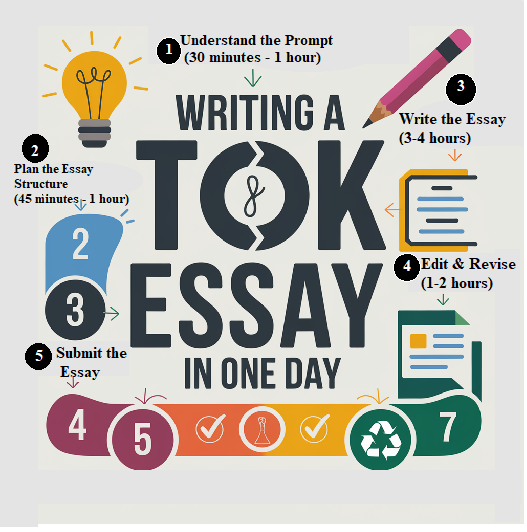Step 1: Understand the Prompt (30 minutes – 1 hour)
Carefully read and analyze the prescribed title
- The IB provides six prescribed titles each session—choose the one that resonates most with you.
- Identify key terms in the question and define them clearly.
Find the underlying Knowledge Question (KQ)
- Every TOK essay revolves around a central knowledge question.
- Example: If the prompt asks about the role of language in knowledge acquisition, your KQ could be:
“To what extent does language shape our perception of reality?”
Consider what Areas of Knowledge (AOKs) apply.
- Choose at least two AOKs (e.g., Natural Sciences, History, Mathematics, Arts, Ethics, Human Sciences, etc.).
- Your AOKs should provide contrasting perspectives to develop a strong argument.
Brainstorm real-world examples
- Think of personal experiences, historical events, scientific discoveries, or ethical dilemmas related to your chosen AOKs.
- Examples should be specific and relevant.
Step 2: Plan the Essay Structure (45 minutes – 1 hour)
A well-organized essay saves time and ensures clarity. Follow this structure:
Introduction (150-200 words)
Introduce the topic and explain key terms
- Define essential words from the question (e.g., “perspective,” “justification,” “truth”).
- Please explain how you interpret the question and why it is essential.
State your thesis
- Clearly outline your argument and stance on the question.
- Example: “While emotion and reason both contribute to knowledge, their roles vary across different Areas of Knowledge, leading to contrasting perspectives on what constitutes truth.” Preview your AOKs and main points
- Mention the two AOKs you will explore and the contrasting perspectives they offer.
Body Paragraphs (3-4 paragraphs, 300-400 words each)
Each paragraph should focus on a single argument and include:
Claim: A clear statement that supports your thesis.
Explanation: Using TOK concepts (e.g., certainty, perspective, justification).
Example: Use a real-world example to illustrate your point.
Counterclaim: Provide an opposing viewpoint.
Evaluation: Weigh both perspectives and connect them to the TOK framework.
Example Structure for a Body Paragraph
First AOK (e.g., Natural Sciences)
- Claim: Scientific knowledge is based on reason and empirical evidence, making it reliable.
- Example: The development of vaccines (e.g., COVID-19 vaccine) through the scientific method.
- Counterclaim: Scientific paradigms shift over time (e.g., Newtonian physics vs. Einstein’s relativity).
- Evaluation: Scientific knowledge is provisional and constantly evolving.
Second AOK (e.g., History)
- Claim: Historical knowledge is subjective and influenced by perspective.
- Example: Differing accounts of the same historical event (e.g., Hiroshima & Nagasaki from Japanese vs. American perspectives).
- Counterclaim: Some historical facts are widely accepted as objective (e.g., World War II started in 1939).
- Evaluation: Historical truth depends on sources and interpretation.
Ensure each paragraph links to the prescribed title to stay focused.
Conclusion (150-200 words)
Summarize key arguments
- Concisely restate your thesis.
- Briefly summarize how your AOKs provided different insights.
Reflect on the implications of your argument
- Discuss how your findings affect knowledge production in different areas.
- Example: “The contrast between scientific objectivity and historical subjectivity highlights the complexity of defining truth across disciplines.”
Consider limitations and future questions
- Acknowledge potential weaknesses in your argument.
- Pose a new question to show deeper engagement (e.g., “How does technological advancement change our understanding of truth?”).
Step 3: Write the Essay (3-4 hours)
Now that you have a strong outline, focus on writing quickly and efficiently:
Follow your outline closely—this saves time.
Write in a formal, academic tone—avoid casual language.
Use transitions to maintain logical flow (e.g., “However,” “On the other hand,” “This suggests that…”).
Cite real-life examples properly—avoid vague or generic claims.
Step 4: Edit & Revise (1-2 hours)
Editing is crucial to ensure clarity and coherence.
Key areas to check:
Structure & coherence: Does each paragraph logically follow from the previous one?
TOK terminology: Have you used key TOK concepts (e.g., justification, evidence, reliability)?
Grammar & clarity: Is your language precise and error-free?
Examples & analysis: Do your examples support your argument effectively?
Word count: Ensure it is within the 1200-1600 words limit.
Final Read-Through
- Read your essay aloud or ask a friend to check it.
- Make final tweaks to improve clarity and flow.
Conclusion
Writing a TOK essay in one day is challenging, but with a structured approach, you can produce a well-organized and insightful piece. Start by thoroughly understanding the question and selecting strong Areas of Knowledge (AOKs) that provide contrasting perspectives. Follow a clear structure, including a well-defined introduction, body paragraphs with strong claims, counterclaims, and real-life examples, and a concise conclusion that reflects on the implications of your argument. Incorporate key TOK concepts throughout to strengthen your analysis. Allocate time for revision to refine your arguments, ensure clarity, and correct errors. With focus, determination, and strategic time management, you can write a high-quality TOK essay in just one day.









 Evan John
Evan John